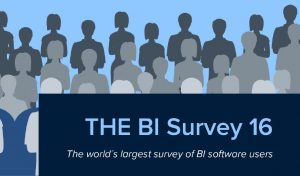 The BARC BI Survey 16 is out, and as has become yearly habit, as soon as I got the report, I dug right in to see what the data shows about customers’ experiences with different business intelligence (BI) vendors and trends in the industry. Of course, I also wanted how to see how Dimensional Insight fared in the report. (Spoiler: we did well! There are some more details in the infographic at the end of this post.)
The BARC BI Survey 16 is out, and as has become yearly habit, as soon as I got the report, I dug right in to see what the data shows about customers’ experiences with different business intelligence (BI) vendors and trends in the industry. Of course, I also wanted how to see how Dimensional Insight fared in the report. (Spoiler: we did well! There are some more details in the infographic at the end of this post.)
For organizations looking to evaluate vendors, the report can be a little daunting at first. Which areas should you focus on? Which KPIs are most important to give consideration to? Here are 3 tips to help you best navigate all the information in the report.
1. Understand the perspective
The BARC BI Survey 16 is a survey of business intelligence users, so it reflects users’ actual experiences with the products they’ve implemented rather than how an analyst has rated the products. It’s important to note this difference because while each perspective has value, this survey is measuring how well vendors are keeping their promises to the customers they’ve sold their products to. This year, BARC surveyed 3,137 BI practitioners about how they’ve used 37 different products. That makes it the largest end-user survey of BI products.
In addition, this report is not a forecast of business intelligence trends. Rather, it reports on what is actually happening with BI implementations. Interestingly, the data reported by end-users sometimes goes against all those futuristic trends that BI analysts forecast.
2. Understand what you want to get out of a BI deployment
What is most important to you as you deploy business intelligence? If you’re looking to get up and running right away, you’ll find in the report a large disparity between average implementation times among vendors. If you’re looking for fast performance, you’ll want to check out KPIs such as query performance. Or if market expertise is important, the report breaks out vendors that have particular penetration in various verticals.
The BARC BI Survey 16 found that quantitative BI benefits (reduced costs, increased revenues, saved headcount) were more difficult to achieve than qualitative benefits such as faster or more accurate reporting and making better business decisions. Do you need the hard ROI numbers? You’ll want to check that the BI vendors you’re evaluating are delivering value to their current customers.
Ultimately, what’s most important is that you consider the factors that will make your BI implementation successful, and evaluate the KPIs through that lens.
3. The report is just one step in your BI evaluation
As previously noted, the BI Survey 16 – similar to some other surveys such as the Wisdom of Crowds BI Market Study – looks at the customer experience with vendors. Of course, the report is just one small step in your BI vendor evaluation. The best way to use this report is to gather information about the vendors that excel in the areas most important to you, and let the information guide your discussions with them. Ultimately, you want to ensure your organization is able to meet its goals, and that the BI solution you select is able to help you do so.
How Dimensional Insight fared in the BARC BI Survey 16
We’re proud to say that as in years past, Dimensional Insight fared very well in the survey. In fact, we received top scores in 14 KPIs.
In addition, BARC put together this infographic that shows how we compared to the average in the various peer groups in which we were included.

- Solving Hospital CEOs’ Pressing Challenges With Analytics - April 15, 2024
- Navigating the Wellness Wave: Wine & Spirits Data Strategy - April 9, 2024
- Takeaways from HIMSS24 - March 26, 2024

